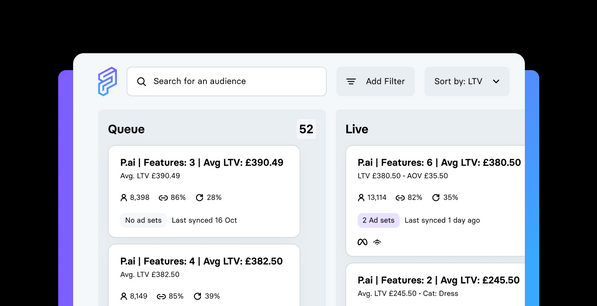When I was a Programmatic Media buyer, getting more bang for your buck was a never-ending chase.
As soon as I hit my cost per action (CPA) target, I got an even lower target. And so it continued.
It wasn’t smart. It wasn’t sustainable. It was a race to the bottom.
While it’s easy to see modern-day advertising at a tactical level, as a series of metrics-driven campaigns designed to reduce cost and drive acquisition, this view often misses the broader challenge or opportunity.
If we take a step back, here are the levers you can pull to improve ad performance:
- Data – to power your targeting, optimisation and measurement
- Creative – messages and imagery that gets attention
- Money – budget to generate sustainable growth
In this piece, let’s focus on the first: Data.
Algorithms are everything in digital advertising. But they’re nothing without good customer-level data to make them work. If we can get a clear picture of your potential customer, then we’re in a much better place to target them with the right creative.
Current state of play
Enough has been written about the current state of play. So let me summarise.
The ad industry operates on third party cookies and mobile advertising IDs. ‘Walled gardens’ like Facebook and Google benefit because they can easily collect all user behaviour around the web and tie it back to user profiles. Advertisers benefit through better ad targeting. Customers benefit through more relevant ads.
As an advertiser, you can’t rely on these walled gardens to collect data for you. If you want to continue to target, measure and optimise your ads with anywhere near the same level of precision, you’re going to need to take action.
In short, you need to collect first party data.
Everything starts and ends with the customer. Once you’ve nailed data collection, you can improve the ways that you create audiences and tailor event data passback to Facebook and Google.
The closer you understand your customer on an individual level, the better you’ll be able to target.
1. Build your baseline.
How do you go about shaping a new first party data strategy?
We know that there’s no one-size-fits-all solution to prepare for the changes. Below, we’ve listed the six things that we believe are important.
Note: these recommendations are tailored for websites. If you’re working with an app, you’ll have the extra challenge of getting your users to opt-in so you can track them on iOS.
- Own the relationship with your customer. When passing first party data to ad platforms, you’ll need an identifier that you can recognise your customer by. An email address usually works, but more is better. You’ll need to build trust and exchange value with your customer for them to give this to you.
- Assign a user ID on site/app. To build a customer profile with first party data, you need to assign an identifier like a customer or user ID. Don’t limit yourself to transactions, loyalty programs or newsletters. This will only give you a small percentage of coverage.
- Incentivise users to log-in whenever they browse your website. If someone is a customer and has a user ID, you want to know it when they browse with you. Get them to log in and you can log their user ID even when they’re not transacting. Rather than forcing this behaviour, how can you incentivise it?
- Connect browsing sessions with a first party cookie. Tools like Google Analytics will assign a first party cookie to any website visitor at browser level. This is called a client ID. It’s sticky unless the user removes it. If you can capture this and the user ID, the two will link automatically. That means you can now connect all other browsing sessions from the same device to enrich the customer’s profile.
- Connect your different data sets to create a single customer view. Once you have an email address, user ID or transaction ID, you can connect your browsing, transactional and email engagement data. Now we’re really getting somewhere…
- Collect parameters passed on from ad platforms. Go one step further. Collect any IDs passed down from ad platforms and referrals. This will help increase your match rates when communicating with the ad platforms about your users. This is level mastery and it’s only really needed if you manage conversion APIs yourself.
2. Use this data to build predictive lookalikes.
If you work through the above checklist, you’re well placed to deal with the upcoming loss of third-party cookies and mobile advertising IDs. But to win, you need to go one step further.
That’s where targeting comes in.
Combine any IDs that you’ve captured by your ad platform along with event data to recreate retargeting-like audiences. Targeting customer audiences or creating lookalikes will continue to work as before. In fact, with more IDs to match against and more user-level data to segment customers, you should actually get more value from them.
With this rich user-level data, you can then predict customer behaviour in the long and short term to power your new and existing customer targeting strategies.
Rather than pushing the majority of spend to customers already looking to purchase (like Facebook’s CPA bidding algorithm), you can go against this. Shift the budget to customers who are on the fence or even unlikely to purchase. This is where you can change customer behaviour and impact the incrementality of your ads.
When acquiring new customers, you shouldn’t solely rely on the Facebook pixel or your CRM to create lookalikes. The former will include customers cancelling or returning orders. The latter is too focussed on ‘best customers’ accumulated through purchases over the years. Instead, select customers predicted to have a high lifetime value. This approach is forward-looking and dynamic.
At Programmai, we call these ‘Seed Audiences’. We refresh these every three to five days. On average, we see a 40% change week on week, so that they change with you and the seasons; always rebuilding your lookalike to attract the right customers into your brands. Never fatiguing.
3. Match event data to your ad platform’s database.
Let’s move to measurement and optimisation.
Most ad platforms will still track post-click events from your ads through first-party cookies. This doesn’t need third party cookies, but it’s just the tip of the iceberg.
You’ll want to supplement the events your ad platform tracks with other events: both post-view and events of users not having seen any ads. The bigger CRMs, CDPs and eCommerce tools will help you do this through conversion API integrations. (Of course, you can set up your own integration too.)
The foundations have been rebuilt. Measurement of ads can go on!
Now, this new status brings along opportunities. Since you’re now asynchronously sending event data back to the ad platforms, you can also modify this data. This means you can optimise differently.
When a customer currently buys your product, the ad platform records the purchase event and basket value in a cookie.
- But what if the customers later cancels the order or returns a product?
- What if your product has low profit margins?
There’s a huge discrepancy between revenue and profit. This discrepancy can vary hugely across orders.
In an ideal world, would you not send predicted order profit – taking into account costs and likely returns – rather than actual order revenue? Or, optimise to predicted customer lifetime value? Again, conversion APIs make this possible. It’s really hard to do this well through pixels and cookies.
Traditional advertising tends to target people with a high likelihood of buying. It doesn’t factor in margins, production costs, returns or cancellations. Over time, it attracts customers who are probably only going to buy from you once or twice.
If you reevaluate what you’re looking for and use your data smartly, you can start targeting people who are unlikely to buy. With the right creative, you can change their mind and start optimising for predicted profit.
With this, I believe you’ve now got the holy grail of advertising in your hands.
In the next part of this series, we’re going to look at exactly this: Creative, the second lever of advertising.
Specifically, we’re going to explore the importance of good creative. The kind that connects with your target audience on a human level.



